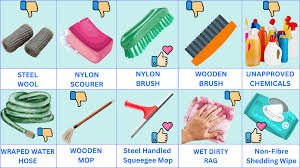Tips to Develop Equipment Cleaning Procedure

✅ Tips to Develop Equipment Cleaning Procedure
-
Risk Assessment First
-
Identify the potential for cross-contamination, product carryover, and microbial risks.
-
Classify equipment as product-contact or non-product-contact.
-
-
Define Cleaning Scope
-
Clearly specify which equipment, parts, and accessories require cleaning.
-
Establish limits for “dirty hold time” and “clean hold time.”
-
-
Select Appropriate Cleaning Agents
-
Choose agents effective against product residues and microbes.
-
Ensure compatibility with equipment material (avoid corrosion or surface damage).
-
-
Standardize Cleaning Methods
-
Manual cleaning (brushing, wiping).
-
Automated cleaning (CIP, COP, ultrasonic).
-
Rinse protocols with WFI or purified water.
-
-
Sequence of Cleaning Steps
-
Pre-rinse to remove bulk residues.
-
Application of detergent/cleaning agent.
-
Mechanical action (scrubbing, pressure jets).
-
Final rinse with approved water quality.
-
Drying and inspection.
-
-
Define Acceptance Criteria
-
Establish limits for product residues, detergent, and microbial load.
-
Base limits on toxicity, potency, and daily dose of the previous product.
-
-
Visual Inspection Standards
-
Include “cleanliness to the naked eye” as a primary step before analytical verification.
-
-
Analytical Verification
-
Swab and rinse sampling.
-
Validated analytical methods (HPLC, TOC, conductivity).
-
-
Documentation & Records
-
Maintain detailed cleaning logs, checklists, and equipment cleaning history.
-
Use “cleaned,” “to be cleaned,” and “not cleaned” status labels.
-
-
Training & Continuous Improvement
-
Regular operator training on procedures.
-
Periodic review of cleaning failures or deviations.
-
Implement improvements based on CAPA, audit findings, or product changes.
🎓 Discover one of the best Pharmaceutical Quality Assurance course available —click below to explore the course that’s shaping future Quality Assurance skills.
https://trcjw.on-app.in/app/oc/306166/trcjw

